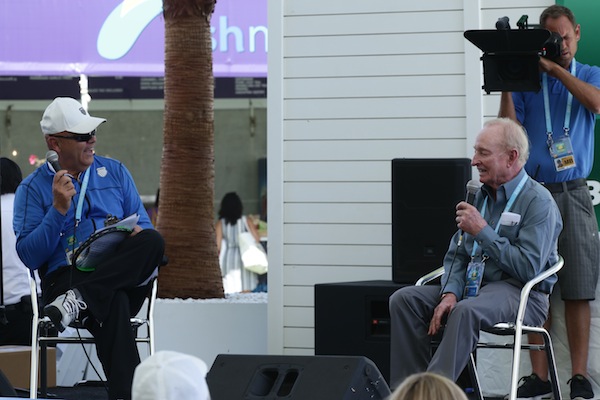
A tennis immortal walked the grounds of the BNP Paribas Open at Indian Wells Tuesday, and a worshipping public made sure to acknowledge that.
Rod Laver was about to be interviewed. The public address system kept letting people know, and by the time he made his way to a stage in the center of this massive complex, around 12:30 p.m., it was clear what people felt about him.
“We love you, Rod,” came a voice from the back.
Wayne Bryan, father of doubles stars Mike and Bob and a tennis promoter and spokesman of some repute in his own right, looked out over the gathering with stunned appreciation.
“I’ve been doing these interviews for four or five years,” he said, “and this is by far the biggest crowd this has ever drawn.”
Bryan should not have been surprised. Nobody should have been.
Laver is not only loved by the tennis world, but cherished. He twice won the sport’s Grand Slam –victories at the Australian, French, Wimbledon and the U.S. Open in a single year—and every time another player takes a run at that, a strong segment of the public quietly roots against it. Laver is sacred. It’s almost like other players simply are not worthy.
Rodney George Laver is five months away from his 78th birthday. He lost his wife four years ago, he fought for years to recover from a stroke, but as he continues to age well and hit the golf ball straight, he also continues to be amazed at how he is perceived by people. He remains the epitome of self-effacing.
After Bryan introduced him with a litany of records, accomplishments and reminders that this wasn’t just any old tennis legend, but a man who has had streets and bridges named after him and whose name is on the main stadium in Melbourne at the Australian Open, Laver reacted in typical fashion.
Bryan: “What do you think when you hear all these things about yourself?”
Laver: “You’re scaring me.”
Later, Laver joked that he understood why there was such a big crowd.
“I’m on my last legs now,” he said. “People are thinking they better see me now.”
He carried the amazement theme further when he said, quite accurately, “When I won the Grand Slams, I didn’t get anywhere near this kind of recognition.”
That’s partly because, when he was winning all four majors in a single year, doing so had not acquired the ring or reputation it has now. Also, every time a player chases a Grand Slam, the public hears again who is being chased. In Laver’s case, the chase for two Slams in two separate years (1962 and ’69), in a sport that now not only pays players handsomely–but also grinds them down–will likely never end. That would make the red-haired lefty from Rockhampton, Australia, even more immortal than he is now. That is, if there is such a thing as degrees of immortality.

photo by cruz moreno
Rod Laver speaks with Wayne Bryan during a special ceremony at the BNP Paribas Open on Tuesday.
He told a great story about how it all began for him, in a small town in a family that made its own tennis court from ant hills.
“You just kind of went out, dug them up,” he said, “carted them to your house and spread it out into a tennis court.”
Laver said he had two older brothers who were good players, plus a mother who played the game well.
“I did my best to see that one brother got home from work before the other one,” Laver said. “That way, I could get two matches. And that way, I could keep the court time, because once they both got home, they wanted to play each other. They were so much better than me.”
But Laver said he also had a way to get around that.
“I’d just go get my mother,” he said, “and we’d have to play mixed doubles. They hated that.”
Laver has a book out. His United States release of it was right here at Indian Wells. The title is obvious: Rod Laver. There is also a sub-title on the cover, a quote from some other guy who plays: “Rod Laver is the greatest champion the sport has known,” says Roger Federer.
The interview program was just a warmup for the real action, Laver’s book signing.
The line snaked two and three deep, and stretched back about 60 yards.
If book-signing lines are yet another gauge of immortality, then they pretty much bronzed a man at Indian Wells Tuesday.
Follow Bill Dwyre on Twitter: @BillDwyre
